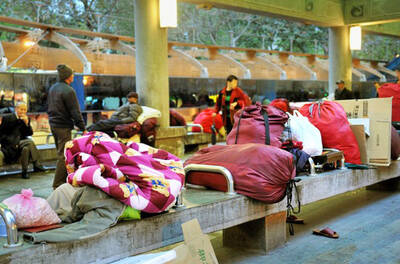Enthusiasts are reporting a massive decline in Alishan’s firefly population this year, as the nation’s Tourism Bureau prepares to open parks for the firefly watching festivals.
The low and medium-altitude regions of the Alishan Range — which runs from Miaoli County to Chiayi County — are home to 42 kinds of fireflies or about two-thirds of all firefly species in Taiwan, the Alishan National Scenic Area Administration said.
The firefly breeding season — the last part of the firefly’s lifecycle — occurs as spring turns to summer, and the nighttime spectacle of the glowing, sprite-like insects draws crowds to the park.

Photo: Tsai Cheng-min, Taipei Times, courtesy of the Tri-Mountain National Scenic Area office
However, while seeing the fireflies is still a breathtaking experience, the dry conditions in central and southern Taiwan had wreaked havoc with their population, according to nature photographers and locals.
“The firefly population is less than one-third of the size it was last year; the lack of rain has been catastrophic to the ecology of fireflies,” photographer Chuang Hsin-jan (莊信然) said.
Chien Tian-shang (簡天賞), a hotel owner in Fongshan Village (豐山), said that water is crucial to fireflies, adding that his community turned on sprinklers in the middle of last month after reports that the fireflies’ food sources were dwindling.
While the size of firefly swarms topped expectations in areas where sprinklers were used, areas where they were not used have almost no fireflies to speak of, he said.
The firefly population’s decline is noticeable, because taking a good photograph of them takes about three minutes of exposure as opposed to 30 seconds in previous years, photographer Huang Yuan-ming (黃源明) said.
“Even then, the results might not be as good,” Huang added.
Taking a clear photograph of fireflies this year requires five minutes of exposure instead of the usual 30 seconds, said Huang Yuan-ming (黃源明), a photographer and retired school principal.
People who want to see the fireflies should go to the Alishan National Scenic Area (阿里山國家風景區), rather than the higher-altitude Alishan National Forest Recreational Area (阿里山國家森林遊樂區), he said.
Places to go include the villages of Chashan (茶山), Fencihu (奮起湖), Fongshan (豐山), Guanghua (光華), Lichia (里佳), Renshou (仁壽), Rueifeng (瑞峰), Ruili (瑞里), Shanmei (山美), Shihzih (十字) and Taising (太興), he said.
Visitors should put red filters on their flashlights and keep noise to a minimum to avoid disturbing the fireflies, he said, adding that using camera flashes, touching the insects and littering are forbidden.
Meanwhile, the Ministry of Transportation and Communications’ Tourism Bureau has begun enrollment for the firefly viewing festival in Miaoli County’s Nanjhuang Township (南庄).
The entry fee is NT$800 per visitor, and each tour group would have 25 slots made available on a first-come, first-serve basis, the bureau said.
The Tri-Mountain National Scenic Area office said that the firefly festival is created in cooperation with the tourism industry in Hsinchu and Miaoli counties, adding that Nanjhuang is a certified member of Cittaslow International, a group for the promotion of slow tourism.
The bureau offers three tours that combine daytime activities in the area with nighttime firefly viewing, the office said.
Tours on offer include a full-day visit of Nanjhuang on Saturday and Sunday next week, with an emphasis on the town’s historic area and village life, it said.
A half-day tour to the Aboriginal community of Shihbi (石壁) would feature the village’s traditional dye craft and firefly viewing on Nan Tien Old Trail (南天古道) on Sunday next week and May 8, it said.
Another half-day tour would feature a pottery workshop during the day and firefly watching on the Sih Shih Er Fen Yungcyuan Ecological Trail (四十二份湧泉自然生態步道) on May 1, it said.
Additional reporting by Tsai Cheng-min

Taiwan’s Liu Ming-i, right, who also goes by the name Ray Liu, poses with a Chinese Taipei flag after winning the gold medal in the men’s physique 170cm competition at the International Fitness and Bodybuilding Federation Asian Championship in Ajman, United Arab Emirates, yesterday.

Costa Rica sent a group of intelligence officials to Taiwan for a short-term training program, the first time the Central American country has done so since the countries ended official diplomatic relations in 2007, a Costa Rican media outlet reported last week. Five officials from the Costa Rican Directorate of Intelligence and Security last month spent 23 days in Taipei undergoing a series of training sessions focused on national security, La Nacion reported on Friday, quoting unnamed sources. The Costa Rican government has not confirmed the report. The Chinese embassy in Costa Rica protested the news, saying in a statement issued the same

A year-long renovation of Taipei’s Bangka Park (艋舺公園) began yesterday, as city workers fenced off the site and cleared out belongings left by homeless residents who had been living there. Despite protests from displaced residents, a city official defended the government’s relocation efforts, saying transitional housing has been offered. The renovation of the park in Taipei’s Wanhua District (萬華), near Longshan Temple (龍山寺), began at 9am yesterday, as about 20 homeless people packed their belongings and left after being asked to move by city personnel. Among them was a 90-year-old woman surnamed Wang (王), who last week said that she had no plans

TO BE APPEALED: The environment ministry said coal reduction goals had to be reached within two months, which was against the principle of legitimate expectation The Taipei High Administrative Court on Thursday ruled in favor of the Taichung Environmental Protection Bureau in its administrative litigation against the Ministry of Environment for the rescission of a NT$18 million fine (US$609,570) imposed by the bureau on the Taichung Power Plant in 2019 for alleged excess coal power generation. The bureau in November 2019 revised what it said was a “slip of the pen” in the text of the operating permit granted to the plant — which is run by Taiwan Power Co (Taipower) — in October 2017. The permit originally read: “reduce coal use by 40 percent from Jan.